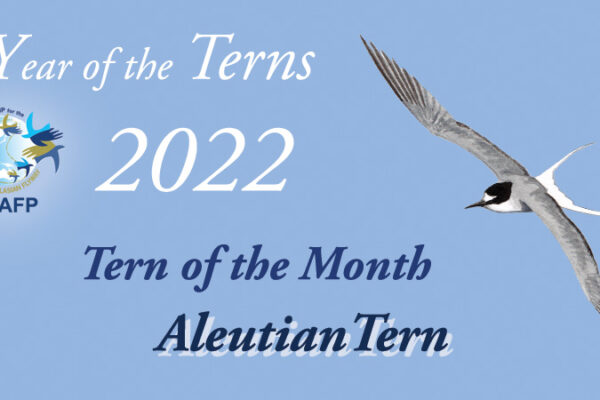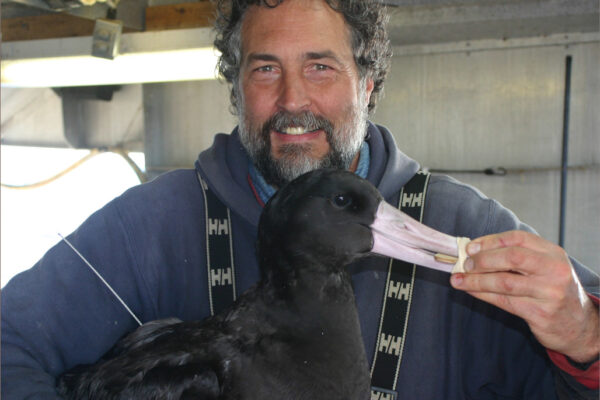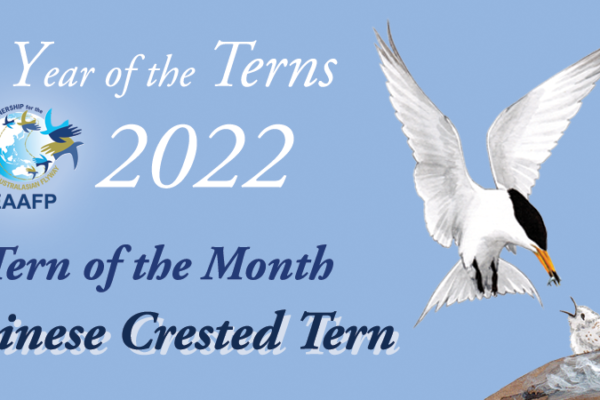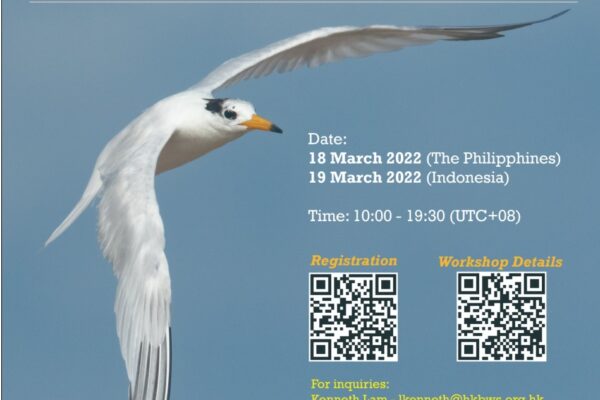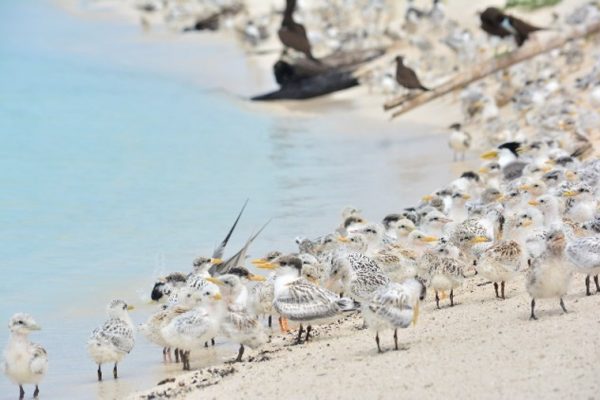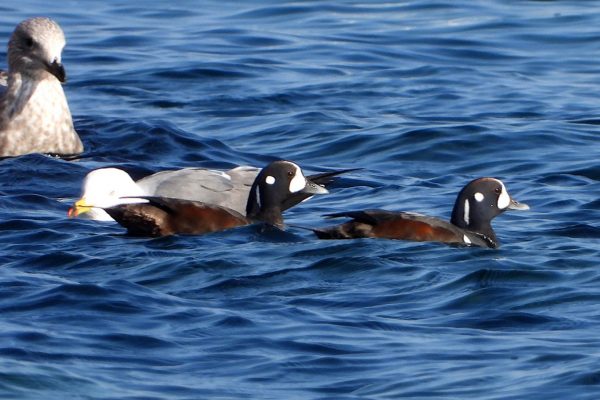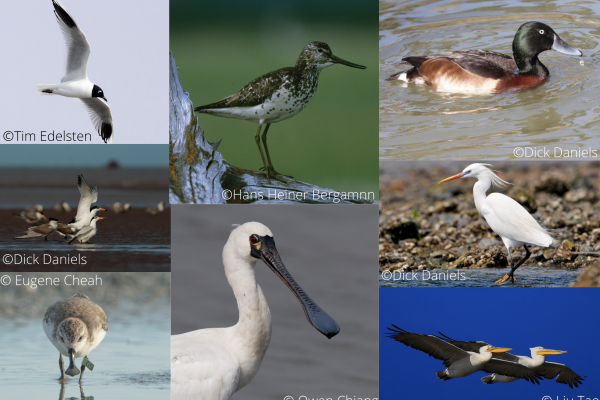-
Aleutian Tern
©️ Kenneth Lam Common name: Aleutian Tern Scientific name: Onychoprion aleutica Local names: 白腰燕鸥 (Simplified Chinese), 白腰燕鷗(traditional Chinese), Алеутская крачка(Russian), 알류샨제비갈매기(Korean) , コシジロアジサシ(Japanese), Daralaut Aleutian (Indonesian), Camar Aleutian (Malayu). Conservation status: IUCN - Vulnerable Aleutian Tern (Onychoprion aleutica) is a representative of an East Asian-Australasian Flyway species. It is a medium-sized, coastal and colonial nesting seabird. The species was discovered in 1868 on Kodiak Island, Alaska, but studies are limited, mainly at breeding grounds. Its breeding ground Aleutian Tern is often found associated with Common Tern or Arctic Tern. The population of the bird is declining and listed as Vulnerable on the IUCN Red List. Identification Size: 32-28cm; wingspan 75-80cm. Body: mid-grey back and has long wings, the underparts are a dark gray, while rump and forked tail are white Head: Breeding – adults have black cap and lore with a white forehead, chin, throat, and cheeks; Juvenile: brownish crown, and upper body Underwing: dark leading edges on secondaries are diagnostic for identication. Beak: Black Legs: Short and black Distribution range Breeding range: at colonies in coastal Siberia, including Sakhalin Island, the Kamchatka Peninsula, the Sea of Okhotsk, and in the Bering Sea at Olyutortskiy Bay and Karagin Island, while in Southwest Alaska, they were found in Kasegaluk Lagoon, on the Seward Peninsula, the Yukon-Kuskokwim River Delta, and along the Alaska Peninsula, as well as the Aleutian Islands, Kodiak Archipelago, Kenai Peninsula, Copper River delta, and along the Gulf of Alaska as far east as Dry Bay. Non-breeding range: in spring and autumn offshore across the East Asia region covering waters in Japan, Korea, China, including Hong Kong and Taiwan, and the Philippines, and in winter found in the tropical western Pacific region including Indonesia, Malaysia and Thailand. Recent vagrant records reached Australia. Habitat The Aleutian tern breeds on wetlands and solitary rocky islands along coasts, particularly at river mouths, along with sparsely vegetated shorelines, grassy meadows, and marshes. It is pelagic during the non-breeding season. Behavior Breeding season occurs from May-August with egg-laying mostly in June, usually nesting among Arctic Terns in Alaska or Common Terns in Russia. Aleutian terns primarily feed on small fish, but also eat insects, crustaceans and zooplankton. They forage by flying, hovering low over water, and then surface-dip or pounce to take the food from the water surface. Population estimate About 31,000 mature individuals. Main threats Habitat degradation Egg harvest and hunting Human disturbance Natural threats: Natural predators (e.g. American Mink, Fox, rats) and domestic dogs Conservation Work Aleutian Tern Conservation Plan and a Statewide Aleutian Tern Colony Census Protocol in Alaska As Aleutian Tern is a species of USFWS and ADF&G “Species of Conservation Concern/Species of Conservation Need”, in 2016, an Aleutian Tern Technical Committee (ATTC) was formally established. The ATTC has members include representatives from US’s federal and state agencies, scientists, and NGOs. ADF&G and collaborators. The recent population declines triggered an assessment of the status of the birds in 2017. Fun Fact Aleutian Tern usually nests among Arctic Terns, who are known to be defensive of their nests, so they can take advantage of this behavior, while Aleutian Terns do not attempt to defend their own nests. Webinar on Chinese Crested Tern in the Yellow Sea and Seabird Conservation in China Black-naped Tern White-winged Tern Greater Crested Tern Roseate Tern Bridled Tern 11th Yakutat Tern Festival Little Tern “Year of the Terns” Flyway Story Series #16 – Prof. Daniel Roby, Seabird researcher and conservationist Chinese Crested Tern
Continue reading -
“Year of the Terns” Flyway Story Series #16 – Prof. Daniel Roby, Seabird researcher and conservationist
As EAAFP is designating 2022 the “Year of the…
Continue reading -
Chinese Crested Tern
©Simba Chan Common name: Chinese Crested Tern Scientific name: Thalasseus bernsteini Local names: 中华凤头燕鸥 (Simplified Chinese), 中華鳳頭燕鷗/黑嘴端鳳頭燕鷗(Traditional Chinese), 뿔제비갈매기 (Korean), ヒガシシナアジサシ(Japanese), Dara-laut Cina (Indonesian), Camar Cina Berjambul (Malayu), Nhàn mào Trung Quốc (Vietnamese). Conservation status: IUCN - Critically Endangered, CMS - Appendix I The Chinese Crested Tern (Thalasseus bernsteini) is one of the rarest seabirds in the world. It seemed it had always been rare. It was not described until 1861, when the type specimen was collected at Kao, Halmahera, Indonesia. Since the last 21 specimens were collected at Qingdao, China in 1937, there was no confirmed record of the species. In 2000, the bird was resighted on Matsu Islands off the coast of Fujian. In 2004 another breeding colony was discovered at Jiushan Islands in Zhejiang Province. With international cooperation using social attraction restored the breeding colony, Chinese Crested Tern is estimated to be about 150 birds in population and is stable or slowly increasing. Identification Size: around 45 cm; wingspan 94 cm. Head: Short crested, Breeding: entire cap turned black with crest; Non-breeding: forehead turned white Beak: bright orange-yellow bill with a black tip and almost invisible white tip at the end of the beak Light grayish from the mantle to upperwing, rump, uppertail-coverts and tail forked tail; black legs Distribution range Breeding range: Since the rediscovery of the species in 2000, there are only five breeding locations: Jiushan Islands, Wuzhishan Islands (Zhejiang, China), Matsu Islands (Fujian, China), Penghu Islands (Taiwan, China) and Chilsando Islands in the Republic of Korea. Non-breeding range: The bird is believed to breed off Shandong formerly, but is now only sighted in coastal areas in Shandong after breeding season. Non-breeding records were from South China, Japan, the Philippines, Thailand and eastern Malaysia. Confirmed recent wintering grounds include Seram, Maluku of Indonesia and Mindanao of the Philippines. Eastern Indonesia and the Philippines are likely to be the major wintering areas for this species. Habitat Breeding habitat of Chinese Crested Tern, Tiedun Dao, Zhejiang, China © Simba Chan Chinese Crested Tern breeds only on offshore uninhabited islets, non-breeding habitat is of little information. Non-breeding ground in Indonesia © Ken Fung Behavior During the breeding season, Chinese Crested Tern usually congregate with Greater Crested Tern nesting areas, but in Ro Korea they nest in colony of Black-tailed Gulls. They can move between different colonies in the breeding season and are very nervous at disturbance. They are very little known during the non-breeding season but are likely to stay in flocks with Greater Crested Terns. However, these two species may not migrate together as previously assumed. Breeding Chinese and Greater Crested Terns in Tiedun Dao, China © Simba Chan Population estimate About 150 individuals of all ages (prior to 2012, only less than 50 individuals). Main threats Human disturbance (people reaching too close to the breeding colonies) Egg collection Other threats: Pollution (water pollution, plastic pollution) Overfishing Natural threats: Typhoons Natural predators (e.g. Peregrine Falcon, snakes, rats) Conservation Work Social attraction setting to restore Chinese Crested Tern in China © Vivian Fu International collaboration to use social attraction technique to restore breeding population Since 2011, an international cooperation project using social attraction (using decoys and playback) restored the breeding colony at Jiushan. The population increased from less than 50 to about 150 in 10 years. Subsequently, Social attraction was also done in breeding grounds of Matsu, Wuzhishan and Chilsando. Remove human-induced threats Through education and advocacy to promote law enforcement to prevent exploitation (egg collection) and disturbance, such as regulated tourism, allocation of park rangers for monitoring, as well as fishing communities and public engagement. Fun Fact Chinese Crested Tern was once thought extinct, so when it was rediscovered after 63 years in 2000, the bird was called “Bird of Legend”. Prior to 1975, the Chinese Crested Tern was known as Sterna zimmermanni Reichenow 1903 and the type locality was thought to be Qingdao of Shandong Province, China (when the team from Fan Memorial Institute of Biology collected 21 specimens from Qingdao area in 1937 all of them were labeled as Thalasseus zimmermanni). It was later on corrected that the type specimen should be the one collected near Halmahera, Indonesia in 1861, which had been misplaced as a population of Greater Crested Tern. Interestingly, when Dr. Nagamichi Kuroda obtained his specimen of Chinese Crested Tern from Korea in 1917 he also regarded it as a Greater Crested Tern. Luckily he left a detailed description of this long-lost specimen for verification to be a Chinese Crested Tern. Reference IUCN Red List: https://www.iucnredlist.org/species/22694585/131118818 Birds of the World: https://birdsoftheworld.org/bow/species/chcter2/cur/introduction Simba Chan, 2022, Chinese Crested Tern (Thalasseus bernsteini). Editor(s): Dominick A. DellaSala, Michael I. Goldstein, Imperiled: The Encyclopedia of Conservation, Elsevier: Pages 19-28 (link Gochang Big Bird Race 2023 brought birdwatchers to contribute bird data to the UNESCO World Heritage Site Special achievement award to the Chinese Crested Tern team Webinar on Chinese Crested Tern in the Yellow Sea and Seabird Conservation in China Chinese Crested Tern banded in Republic of Korea sighted in China Restoration of the Critically Endangered Chinese Crested Tern using social attraction technique A Conservation Success in Minjiang River Estuary A tern for the better Critically Endangered Chinese Crested Terns appear on a deserted island in South Korea The First Ever Banded Chinese Crested Tern Chick has Fledged EAAFP Seabird Working Group Update
Continue reading -
Seabird Training Webinars for Southeast Asia
The Hong Kong Bird Watching Society (HKBWS, an EAAFP Partner) has been engaging with an international team established for the conservation of…
Continue reading -
The First Asian Ornithological Conference convened
The last two decades have seen a tremendous increase in the development of scientific studies and conservation of birds in Asia. The…
Continue reading -
The Third World Seabird Conference: seabird study and conservation in Asia
The Third Seabird World Conference was held virtual from 4 to 9 October 2021 (covering all time zones). It was scheduled to be convened in Hobart, Australia in 2020…
Continue reading -
EAAFP Small Grant Fund project: 2021 Tubbataha Seabird Survey, Philippines
Seabirds spend their entire life in the open ocean, hence, they are a good indicator of coral reef health. Their nutrient-rich droppings fertilize roosting grounds and the surrounding water to the benefit of other marine life. Seabirds are one of the most highly threatened species of animals. Although they have a relatively long life span, they breed much slower and have fewer offspring than other birds in general. Partly supported by EAAFP Small Grant Fund for Working Groups and Task Forces, this year, the Tubbataha Management Office (TMO) use seabirds as an indicator to assess of how well – or how badly – the site are conserving Tubbataha Reefs Natural Park, A Flyway Network Site (EAAF 123) in the Philippines. We monitored the population of the seven species that breed in the Park, the: Red-footed Booby (Sula sula), Brown Booby (Sula leucogaster), Masked Booby (Sula dactylatra), Great Crested Tern (Thalasseus bergii), Sooty Tern (Onychoprion fuscata), Brown Noddy (Anous stolidus), and endemic Black Noddy subspecies (Anous minutus worcesteri). We use various monitoring methods and integrate results for a more accurate estimate of the populations. Distance counts are conducted once a month, while direct counts are done once a quarter. In-flight counts are done late in the afternoon, and dawn counts are made before the birds leave the islet to forage for food. When called for, we would do night counts of birds that come to roost after sundown. Adults, subadults, juveniles, pullus, eggs, and nests of each species are counted. Two teams conduct the count of the various species in various life stages. In all, it took a total of 39 teams to complete the survey. In May each year, we join the marine park rangers (MPR) for quarterly monitoring. The Covid 19 situation interposed several complications that delayed our trip, with interesting results. Together with WWF-Philippines staff, and volunteers, we were finally able to set sail on 2 June 2021. This year’s survey was funded by the East Asian-Australasian Flyway Partnership (EAAFP), Department of Environment and Natural Resources (DENR), and Pilipinas Shell Foundation, Inc. (PSFI). Report of the surveys will be shared by the end of 2021. Tubbataha Reefs Natural Park is both a Ramsar site and a Flyway Network Site of the EAAFP. Located 92 nautical miles southeast of Palawan, it is a 97,030-hectare marine protected area which was established on 11 August 1988. It is the largest no-take marine protected area in the Philippines. Its two islets are among the last known safe breeding habitats of seabirds in Southeast Asia. Article prepared by Tubbataha Management Office. The Tubbataha Reefs Natural Park is in the middle of the Sulu Sea. It is composed of two atolls and a reef. The Bird Islet is in the North Atoll and the smaller South Islet is located in the South Atoll. Marine park rangers construct the ‘Tubbataha Hilton’, our shelter from the sweltering heat in Bird Islet. Photo © Segundo Conales Jr Our team from Puerto Princesa City met with MPRs at the ranger station upon arrival. Research Officer Retch Alaba gave a briefing on the work at hand and assigned tasks for each person. Photo © Rowell Alarcon Our first task before setting foot on the islets was to do a distance count. Park Ranger Jeffrey David (in blue) leads the count in Bird Islet, where 80% of the total seabird population of Tubbataha reside. Photo © Rowell Alarcon In the following days, the teams got busy with their respective tasks. Here, one group counts the eggs of the Great Crested Tern. Photo © Kymry Delijero Showing off their EAAFP hats, Angelique Songco and Rowell Alarcon count Brown Noddies. Photo © Kymry Delijero Marine Park Ranger Segundo Conales Jr., (with umbrella) counts the eggs, nests, and adults of Black Noddy in the structure while John Eric Magbanua, Bantay Dagat of Local Government of Cagayancillo (LGU), serves as recorder. Photo © Retch Alaba From left: MPR Noel Bundal, SN2 Paul Balonsay PN, and Joan Pecson, WWF-Philippines, start the in-flight count at 4:30, when birds begin to arrive from the day’s foraging. Photo © Kymry Delijero The team doing a night count of the Sooty Tern population that landed after sundown. The estimate was 6000 individuals! Photo © Kymry Delijero From left to right: Marine Park Rangers Segundo Conales Jr, SNDP Paul Balonsay PN, SN2 Francis Lim and Noel Bundal (in blue shirt) with tallies their day’s count in the native dining table inside our hut. Photo © Kymry Delijero We observed lesser seabirds, probably because we arrived at the end of the breeding season when most of the adults have left. We also counted lesser eggs because most of the birds were already in the pullus or juvenile stages. Photo © Kymry Delijero Black Noddies continue to occupy the artificial nesting structures we built in 2017. Last year, we added new structures made of PVC and steel pipes (above), which are designed to last longer. Photo © Gerlie Gedoria We planted saplings of native trees in the islet in 2020 but most did not survive. Marine Park Rangers Amado Cayabo (LGU) and Cris Caranay (TMO) construct bamboo guards around a sapling so birds would not build their nests on the saplings and use their leaves as nesting materials. Photo © Kymry Delijero The only known breeding Masked Booby in Philippines lain an egg for the fourth time (!) since 2019. A second egg appeared a week later. Photo © Retch Alaba We used the WWF-Philippines research vessel, M/Y Navorca for the survey. Here, the team disembarks for the survey in South Islet. Photo © Rowell Alarcon This year's seabird survey team. Photo © Rowell Alarcon
Continue reading -
Seabird Survey in Goseong, Ro Korea
On 9 February 2021, Mr. Doug Watkins, Chief Executive, Ms. Vivian Fu, Communication Officer, and…
Continue reading -
What does the revised China Protected Species list mean for EAAFP?
February 5th, the Chinese government announced the publication of…
Continue reading -
The international policy framework for seabird conservation in the South Pacific
By Eduardo Gallo-Cajiao, Evan Hamman, and Brad K. Woodworth A newly published book Environmental law and governance in the Pacific: climate change, biodiversity…
Continue reading

